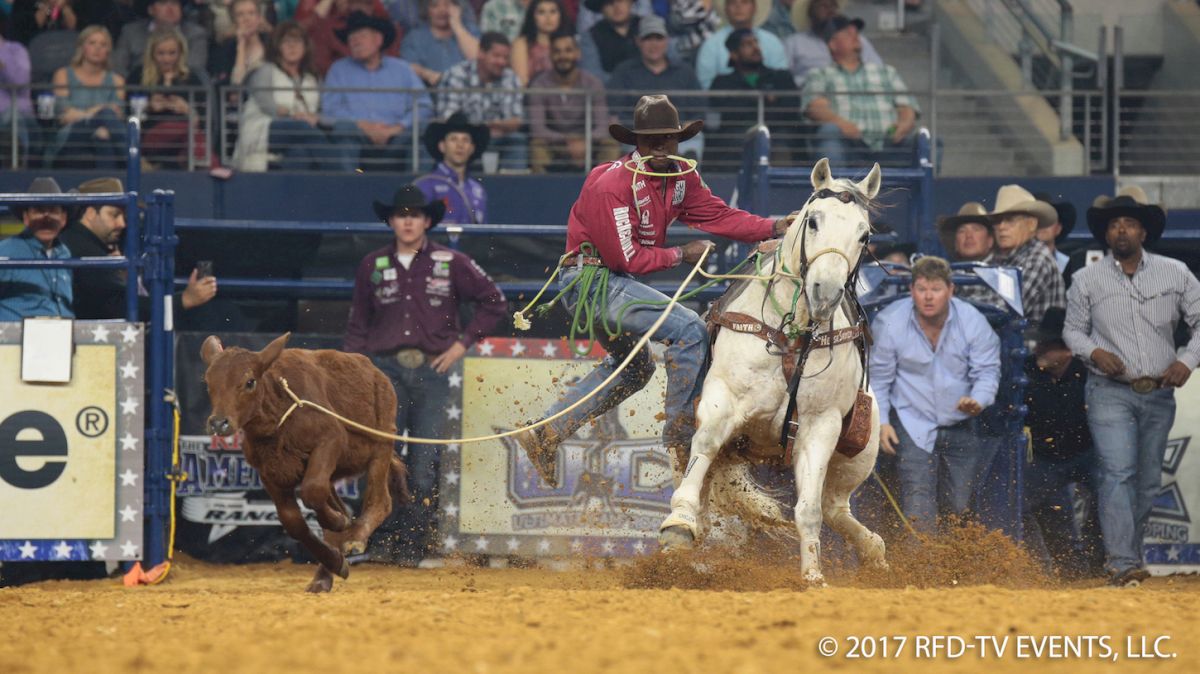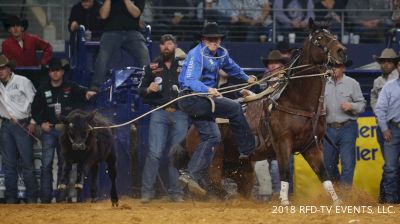Should Solomon Have Won The American? Timing Discrepancy Raises Question
Should Solomon Have Won The American? Timing Discrepancy Raises Question
After a lot of conversation online about Marty Yates and Cory Solomon's runs in the shoot-out the The American, we wanted to take a deep look at the issue.

There has been a lot of conversation online about the potential discrepancy between Marty Yates and Cory Solomon’s shoot-out round runs at The American. Some think they clocked Solomon as fast as 5.7, and many have screenshots of both Solomon and Yates finishing their runs with 5.9 seconds on the on-screen time clock.
While there is no way to deny that, yes, things happen to make rodeo the unfair sport it can sometimes be, there are a few things you need to consider before formulating your own opinion about the situation.
Factors To Consider:
- The time clock on the screen is not the official time clock; it is only for you to roughly follow along during the rodeo. So remove any notion that a screenshot showing “5.9” seconds has any bearing on what the time actually is.
- Solomon slightly jammed or fumbled his hooey, and that makes a flagger really watch the end of your run to see a definitive "finish." When the run ends smoothly, you may get a slightly faster flag because of the fluid motion; in contrast, when there is a hiccup in the run, the judging has the potential to go either way. You could get a faster flag than you deserve because the judge "expects" the run to be over when your fumble actually slows it down, or you could get a slightly slower flag if the judge catches the fumble and waits until they know you have completed the run.
- Solomon also raised one hand while the other was finishing the tie and started to stand up before his run was actually complete. This is something many competitors do out of habit, and when a 6.37-second run is needed to win the rodeo, you can bet Solomon’s motor was rolling. This can create the illusion of a faster run, and a judge that is not on his toes may take this as the end of the run and actually end up flagging them early; the judge at The American caught this and was waiting until both of Solomon’s hands were in the air.
- The human element. We don’t have robots flagging and timing, so yes, there is room for slight variations in flag drops and stop watch clicks. It is difficult to duplicate the same scenario when you have now seen the run, and are basing your time off of when Solomon or Yates throw their hands up, not when the flagger drops their flag as the timer must do.
Let’s get technical now.
Analyze the two runs side-by-side to see if you believe there was in fact a large discrepancy. Don’t look at the time clock on the screen — really watch for both Yates and Solomon to finish their runs and get both hands in the air, and know that just because you clock them faster than they are only means that you’ve cut out the flagger from the equation which will of course make the run faster but is not the reality of a rodeo timer’s job.

- Auto

- Auto
What Can We Do Moving Forward
Whether you believe Solomon’s run should have won The American or not is invalid at this point. What is valid is searching for a solution to ensure that in the future there is no doubt as to who wins the world’s largest rodeos.
Do we keep hoping the “rodeo gods” will even things out in the end? You may get a slow flag or a low score once and hope for a quick flag or a padded score later.
Or do we look to technology to remove the possibility of timing and call variation?
If that is the case, we can look to the Olympics, which has methodically incorporated technology into their timing systems.
One method, introduced in 1932 in Los Angeles when Omega became the official timekeeper of the Olympic Games, became known as the “Kirby Camera." The device could simultaneously photograph the finish line as well as featuring a chronometer to time-stamp each shot.
The technology has changed and improved over time, but the basics of the technology still remain the same and could be applied to rodeo by marking a specific start and stop frame to each timed event run, and to make sure roughstock riders complete their eight second rides.
If rodeo did decide to remove the human element and simply use photo or video technology to determine the time, here are some things to consider:
- We need much more exact start and stop points.
- In the roping events, is it the very first instance we can see the barrier rope has disconnected from the pin? In the roughstock, is it the very first hair of the horse or bull we can see past the plane of the chute that starts the eight seconds?
- When we stop the run, what is considered “hands up” in the tie-down roping? Is it the moment both hands leave the piggin' string, do they have to be above their shoulders, what is it is someone’s style to throw their hands out, not up? In other events like steer wrestling and team roping, the same specificity would need to be defined for when a run is actually considered "done."
- Camera angles: the best possible camera angle must be used to catch both the start and stop of every ride or run. A good view throughout the run or ride is also a must to make sure anyone that disputes a call, can get a clear replay view to decide if the call was valid.
- Would we use this for every run or ride? Or just when they are disputed? Using it for every run would require someone to "tag" the very first and last frame of each run or ride, slowing the event down.
Improvements We’ve Already Seen
Advancements for rodeo are slowly being made — at The American, for example, they time down to at least the hundredth of a second, where most rodeos time to the tenth in every event but the barrel racing. Video replay is also used at the event if a contestant feels a call needs to be reviewed.
For example, Trevor Brazile received a replay review when he believed he had caught his rope on the barrier line in the team roping but it was found he hit it on the stationary post, so no rerun was awarded. Steer wrestler Ty Erickson also contested the judge’s call that he did not have all four feet of his steer out to signal the end of his run; the video replay found that the judge was correct and the no-time remained.
The PBR also introduced some new technology years ago that allows calls to be reviewed. The association has a “replay button” that not only can the competitor in question push, but any other competitor of the event, the judges, or the stock contractors. Pushing the button means you will bet $500 that the call should be overturned; if you are correct you keep your money, if the call is not overturned the challenger pays $500.
Let's also not forget how far the judging system itself has come. In the "good ol'days" a judge may have just been a competitor that was injured the weekend before and simply hopping in to help out, now there are judging clinics, certifications, and at times you will see head judges that oversee the event.
The sport of rodeo has always been slow to embrace technology, but with contestants constantly breaking records, the pool of top contenders continuing to deepen through strong youth programs, and big-money events popping up all the time, is it time to let more timing technology in?